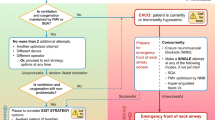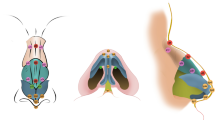Abstract
Objective: To compare the effectiveness of nebulised L-epinephrine in combination with systemic or nebulised corticosteroid with that of cool mist and systemic corticosteroids in the treatment of moderate to severe croup.
Patients and methods: Children were eligible for study if they presented to the emergency department with a moderate to severe croup. Patients were randomly assigned to three groups: group 1, cool mist and intramuscular dexamethasone (n = 26); group 2, nebulised L-epinephrine and intramuscular dexamethasone (n = 31); group 3, nebulised L-epinephrine and nebulised budesonide (n = 19). The croup score, vital signs and oxygen saturation were assessed before and after medication. Adverse events, additional L-epinephrine and hospitalisation were recorded.
Results: Age, sex, initial croup score and vital signs were similar in all groups. Croup scores were significantly decreased over time in all treatment groups and this decrease was very evident at 30 minutes (p < 0.05). Croup scores of groups 2 and 3 were significantly lower than those of group 1 at 30 and 60 minutes but no difference was observed between groups 2 and 3 at these timepoints. The numbers of patients who had croup scores <2 at 30 and 60 minutes were higher in groups 2 and 3 than group 1 (p = 0.004 and p = 0.032, respectively). More patients in group 1 received additional L-epinephrine treatments (p = 0.014). Changes in vital signs were not different among groups when assessed over time (p > 0.05).
Conclusions: This study demonstrated that with early combination treatment, croup scores improved rapidly and hospitalisation rates were low. Patients with moderate to severe croup presenting to the emergency department should receive nebulised L-epinephrine in combination with intramuscular dexamethasone or nebulised budesonide. No significant adverse effects were observed with L-epinephrine. The use of L-epinephrine has been proposed instead of racemic epinephrine in patients with moderate to severe croup because it is efficacious, well tolerated, less expensive and more readily available in many countries.





Similar content being viewed by others
Notes
The use of trade names is for product identification purposes only and does not imply endorsement.
References
Denny FW, Murphy TF, Clyde Jr WA, et al. Croup: an 11-year study in a pediatric practice. Pediatrics 1983 Jun; 71(6): 871–6
Roseveit GE. Acute inflammatory upper airway obstruction. In: Behrman RE, Kliegman RM, Jenson HB, editors. Nelson textbook of pediatrics. 17th ed. Philadelphia (PA): Saunders Company, 2004: 1405–9
Fitzgerald DA, Kilham HA. Croup: assessment and evidence-based management. Med J Aust 2003 Oct; 179(7): 372–7
Griffin S, Ellis S, Fitzgerald-Barron A, et al. Nebulised steroid in the treatment of croup: a systematic review of randomised controlled trials. Br J Gen Pract 2000 Feb; 50(451): 135–41
Klassen TP, Craig WR, Moher D, et al. Nebulized budesonide and oral dexamethasone for treatment of croup. JAMA 1998 May; 279(20): 1629–32
Donaldson D, Poleski D, Knipple E, et al. Intramuscular versus oral dexamethasone for the treatment of moderate-to-severe croup: a randomized, double-blind trial. Acad Emerg Med 2003 Jan; 10(1): 16–21
Roberts GW, Master VV, Staugas RE, et al. Repeated dose inhaled budesonide versus placebo in the treatment of croup. J Paediatr Child Health 1999 Apr; 35(2): 170–4
Geelhoed GC, Macdonald WB. Oral and inhaled steroids in croup: a randomized, placebo-controlled trial. Pediatr Pulmonol 1995 Dec; 20(6): 355–61
Kelley PB, Simon JE. Racemic epinephrine use in croup and disposition. Am J Emerg Med 1992 May; 10(3): 181–3
Prendergast M, Jones JS, Hartman D. Racemic epinephrine in the treatment of laryngotracheitis: can we identify children for outpatient therapy? Am J Emerg Med 1994 Nov; 12(6): 613–6
Waisman Y, Klein BL, Boenning DA, et al. Prospective randomised double-blind study comparing L-epinephrine and racemic epinephrine aerosols in the treatment of laryngotracheitis (croup). Pediatrics 1992 Feb; 89(2): 302–6
Bertrand P, Aranibar H, Castro E, et al. Efficacy of nebulized epinephrine versus salbutamol in hospitalized infants with bronchiolitis. Pediatr Pulmonol 2001; 31(4): 284–8
Fitzgerald D, Mellis C, Johnson M, et al. Nebulized budesonide is as effective as nebulized adrenaline in moderately severe croup. Pediatrics 1996 May; 97(5): 722–5
Bourchier D, Dawson KP, Fergusson DM. Humidification in viral croup: a controlled trial. Aust Paediatr J 1984 Nov; 20(4): 289–91
Lenney W, Milner AD. Treatment of acute viral croup. Arch Dis Child 1978 Sep; 53(9): 704–6
Neto GM, Kentab O, Klassen TP, et al. A randomized controlled trial of mist in the acute treatment of moderate croup. Acad Emerg Med 2002 Sep; 9(9): 873–9
Kairys SW, Olmstead EM, O’Connor GT. Steroid treatment of laryngotracheitis: a meta-analysis of the evidence from randomized trials. Pediatrics 1989 May; 83(5): 683–93
Klassen TP. Croup: a current perspective. Pediatr Clin North Am 1999 Dec; 46(6): 1167–78
Ausejo M, Saenz A, Pham B, et al. The effectiveness of glucocorticoids in treating croup: meta-analysis. BMJ 1999 Sep; 319(7210): 595–600
Geelhoed GC. Sixteen years of croup in a Western Australian teaching hospital: effects of routine steroid treatment. Ann Emerg Med 1996 Dec; 28(6): 621–6
Westley CR, Cotton EK, Brooks JG. Nebulized racemic epinephrine by IPPB for the treatment of croup: a double-blind study. Am J Dis Child 1978 May; 132(5): 484–7
Drugs for pediatric emergencies. Committee on Drugs, 1996 to 1997, Liaison Representatives, and AAP Section Liaisons. Pediatrics 1998 Jan; 101 (1): E13
Johnson DW, Jacobson S, Edney PC, et al. A comparison of nebulized budesonide, intramuscular dexamethasone, and placebo for moderately severe croup. N Engl J Med 1998 Aug; 339(8): 498–503
Tibballs J, Shann FA, Landau LI. Placebo-controlled trial of prednisolone in children intubated for croup. Lancet 1992 Sep; 340(8822): 745–8
Rittichier KK, Ledwith CA. Outpatient treatment of moderate croup with dexamethasone: intramuscular versus oral dosing. Pediatrics 2000 Dec; 106(6): 1344–8
Henry R. Moist air in the treatment of laryngotracheitis [letter]. Arch Dis Child 1983 Aug; 58(8): 577
Skolnik NS. Treatment of croup. A critical review. Am J Dis Child 1989 Sep; 143(9): 1045–9
Sasaki CT, Suzuki M. The respiratory mechanism of aerosol inhalation in the treatment of partial airway obstruction. Pediatrics 1977 May; 59(5): 689–94
Ophir D, Elad Y. Effects of steam inhalation on nasal patency and nasal symptoms in patients with the common cold. Am J Otolaryngol 1987 May–Jun; 8(3): 149–53
Szilagyi PG. Humidifiers and other symptomatic therapy for children with respiratory tract infections. Pediatr Infect Dis J 1991 Jun; 10(6): 478–9
Acknowledgements
There was no financial support for this study. The authors have no potential conflicts of interest directly relevant to the contents of this manuscript.
Author information
Authors and Affiliations
Corresponding author
Rights and permissions
About this article
Cite this article
Duman, M., Özdemir, D. & Atasever, S. Nebulised L-Epinephrine and Steroid Combination in the Treatment of Moderate to Severe Croup. Clin. Drug Investig. 25, 183–189 (2005). https://doi.org/10.2165/00044011-200525030-00004
Published:
Issue Date:
DOI: https://doi.org/10.2165/00044011-200525030-00004




